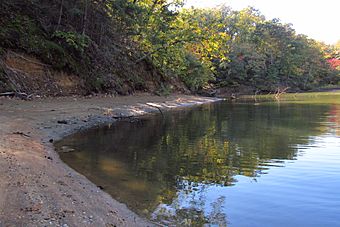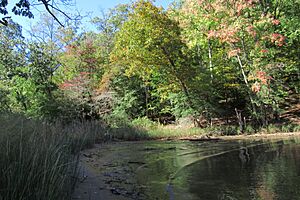Martins Pond Site facts for kids
Quick facts for kids |
|
|
Martins Pond Site
|
|

South view of Martins Pond
|
|
| Lua error in Module:Location_map at line 420: attempt to index field 'wikibase' (a nil value). | |
| Nearest city | Annapolis, Maryland |
|---|---|
| NRHP reference No. | 75000862 |
| Added to NRHP | June 05, 1975 |
The Martins Pond Archeological Site is a special place near Annapolis, Maryland. It is an archaeological site, which means it's a spot where people have found old things. These finds help us learn about how people lived a very long time ago.
This site is important because it shows us about the Middle-Late Woodland period. This was a time when Native American people lived in the area. The site was added to the National Register of Historic Places in 1975. This list helps protect important historical places in the United States.
Contents
What is an Archeological Site?
An archaeological site is like a giant puzzle. Scientists called archaeologists dig carefully to find clues. These clues are objects left behind by people from the past. They can be tools, pottery, or even old food remains.
By studying these clues, archaeologists can understand ancient cultures. They learn about daily life, what people ate, and how they built their homes. Martins Pond is one of these important puzzle pieces.
Exploring the Woodland Period
The Woodland period was a long time in Native American history. It lasted from about 1000 BC to 1000 AD. During this time, people in North America started to live in more settled villages. They also began to grow some of their own food.
People in the Woodland period made pottery and used bows and arrows. They also built large earth mounds for burials or ceremonies. The Martins Pond site helps us understand how people lived during the middle and late parts of this period.
Daily Life at Martins Pond
Life at Martins Pond during the Woodland period was likely focused on nature. People would have hunted animals for food and gathered wild plants. They used stone tools for many tasks.
The nearby pond would have been a source of water and food. It also attracted animals, making hunting easier. People probably lived in small groups or villages near the pond.
What Was Found at Martins Pond?
Archaeologists found different kinds of remains at Martins Pond. These finds tell us a lot about the people who lived there. The main types of remains are lithic, floral, and faunal.
Lithic Remains
"Lithic" means anything made of stone. At Martins Pond, archaeologists found stone tools. These might include arrowheads, spear points, and tools for scraping or cutting. Finding these tools helps us understand how people hunted and prepared food.
Floral Remains
"Floral" refers to plant remains. These can be tiny seeds, pollen, or charcoal from old fires. Plant remains tell us what kinds of plants people ate. They also show if people were starting to farm.
Faunal Remains
"Faunal" means animal remains. These are often bones or shells. Animal bones show what animals people hunted. They also tell us about the environment at that time. For example, finding fish bones means people fished in the pond.
Why is Martins Pond Important?
The Martins Pond site is important for several reasons. It helps us learn about the history of Anne Arundel County, Maryland. It also adds to our knowledge of the Woodland period in Maryland.
By studying sites like Martins Pond, we can understand how ancient people lived. We learn about their skills, their diet, and their connection to the land. Protecting these sites helps us preserve history for future generations.


